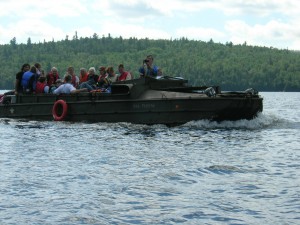Pog has seen a curious variety of airplanes which have dropped into the lake, from a Curtiss Lark in 1926, to a Grumman Goose in 1948. Over the years, however, the most common of all has been the de Havilland Beaver.
But there is one metalic creatures that can’t get off the ground, nor was it ever meant to. It’s an amphibious vehicle that’s built for water and land, better known as a duck, or more correctly a DUKW.
You’ve probably seen these DUKWs in WW II movies, in Saving Private Ryan or The Longest Day, as they were designed to bring troops ashore for amphibious landings. So why is a military vehicle at Pog?
In order for us to get to our camps on Lake Pogamasing we first get off at our CP railway stop at Sheahan. Then we have a hike to the lake of a kilometre or so, with the added obstacle of crossing the Spanish River. It’s pretty onerous to get all the people and supplies from the station to the lake. We then have an additional three kilometres of water to cover. A lot of loading, unloading and carrying! What we needed was a vehicle that we could load everyone and everything in to at the station without having to unload until we reached our camp.
Which is exactly what a DUKW can do.
Ray McTavish, a good friend of our family, knew about DUKWs because he commanded one in the Pacific in WW II . He convinced my uncle, Bill Plaunt, to be on the look-out for one as he believed it would make our life much easier. Eventually my uncle found one through an ad in the Globe and Mail in 1959 by Ducky Tours in Halifax. It was soon on the way to Sudbury.
After a check up in Sudbury we headed up Highway 144 and then on to the Spanish River, accessing it from a former winter logging road near Benny. The incredibly rough road caused the front axle springs to break, causing a puncture of the hull. Consequently, when we entered the Spanish we had two serious leaks, along with some other challenges: a high water level that created a very fast currect, the spring pulp drive and very large boulders to content with. Our confidence about the DUKW’s invincibiity was soon shattered after it sank within eyesight of Pogamasing station, just three kilometres from our lake. A more detailed description of the upstream voyage is found in Chapter 19.
The good news is that the DUKW eventually reached Pog, six weeks later, and became all that we hoped it would be for hauling people and goods. It was so good that we have gone on to acquire additonal DUKWs as the original one couldn’t take the heavy wear and tear of the old roads and loads.

If you check out the slide show in ABOUT THE BOOK you will see how we brought our new DUKWs to Pog.


{ 2 comments… read them below or add one }
Hi Andy –
Dad passed the link on to me. Great that you are doing this. I’m looking forward to the book. Website looks good. Makes me want to be at Pog.
D
The site looks great and I’m glad to hear your book will soon be published. Congratulations!